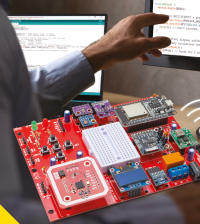- How to Adjust X and Y Axis Scale in Arduino Serial Plotter (No Extra Software Needed)Posted 6 months ago
- Elettronici Entusiasti: Inspiring Makers at Maker Faire Rome 2024Posted 6 months ago
- makeITcircular 2024 content launched – Part of Maker Faire Rome 2024Posted 9 months ago
- Application For Maker Faire Rome 2024: Deadline June 20thPosted 10 months ago
- Building a 3D Digital Clock with ArduinoPosted 1 year ago
- Creating a controller for Minecraft with realistic body movements using ArduinoPosted 1 year ago
- Snowflake with ArduinoPosted 1 year ago
- Holographic Christmas TreePosted 1 year ago
- Segstick: Build Your Own Self-Balancing Vehicle in Just 2 Days with ArduinoPosted 1 year ago
- ZSWatch: An Open-Source Smartwatch Project Based on the Zephyr Operating SystemPosted 1 year ago
Obsidian ESP32 Board in a Raspberry Pi Form Factor

A new open source Espressif ESP32-based board offering a form factor similar to popular single board computers such as the Raspberry Pi Model A / 3 Model A+ has been launched via the Crowd Supply website this month and takes the form of the Obsidian ESP32.
Obsidian ESP32 is an Espressif ESP32-based board adopting the familiar form factor of popular single board computers like Raspberry Pi. This allows you to use wide variety of ready-made Raspberry Pi peripherals (or other peripherals) with the Arduino IDE, Espressif IDF, or MicroPython. The Raspberry Pi form-factor also allows you to use cases and accessories that are already on the market. And you can do it all with low power consumption.
Obsidian ESP32 specifications:
- Wireless module – Espressif Systems ESP32-WROVER-B 802.11 b/g/n WiFi + Bluetooth 4.2 / BLE module with 16 MB flash, 8 MB PSRAM
- USB – 1x micro USB port for power and programming
- Audio – 3.5mm TRS audio jack connected to ESP32 DACs
- Expansion
- 40-pin GPIO header compatible with popular HAT expansion boards with 3.3 V signalling, I²S for audio DAC, I²C and SPI, Serial UART available on header or via microUSB, I²C GPIO expander with interrupts & address selection
- 8-pim unpopulated header from remaining I/Os accessible through GPIO expander
- 5-pin unpopulated header with analog inputs connecting to the ESP32’s SENSOR_VP and SENSOR_VN pins
- Misc – Hardware buttons for reset and a selectable boot option in parallel with USB controlled signals
- Power Supply
- 3.3 and 5 V on GPIO
- 5V via MicroUSB connector
- Additional 5V input through 2x 2.54 mm spaced holes on the board
- 2x 3.3V regulators for ESP32 and GPIO
- Dimensions – ~65 x 56 mm following Raspberry Pi Model A form factor and compatible with Raspberry Pi cases
Obsidian ESP32 supports the ESP-IDF framework, ESP32 Arduino Core and MicroPython, while the board has been designed with KiCad and the hardware design files such as the schematics and PCB layout will soon be released under the CERN OHL v1.2 license.















